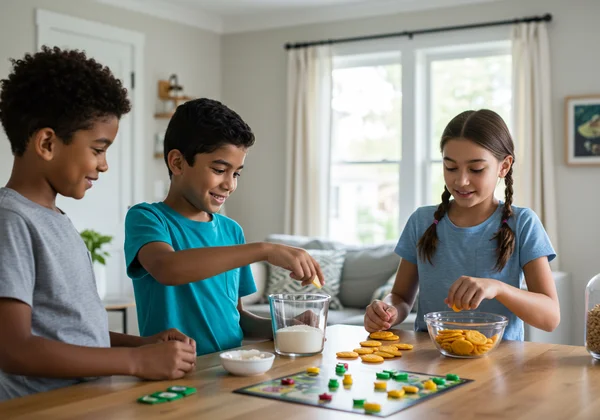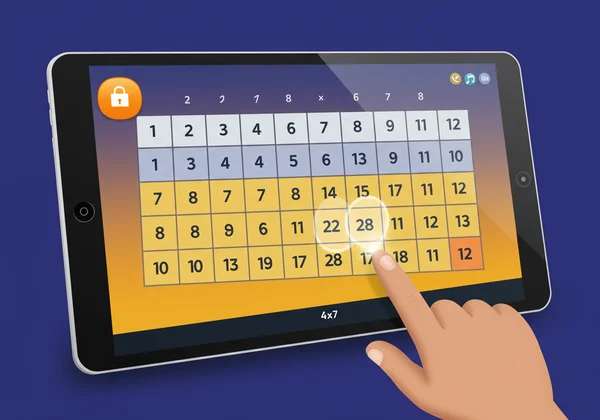The Ultimate Guide: Learn Times Tables & Master Multiplication
Starting your journey to multiplication mastery can seem daunting, but it doesn't have to be. For students, it can feel like a mountain of numbers to memorize. For parents and teachers, the challenge is finding a way to make the process effective and, dare we say, fun. This ultimate guide will demystify learning multiplication, providing strategies, tips, and resources to help everyone navigate this crucial math skill with confidence. What are the easiest ways to learn multiplication? It starts with the right tools, and you'll soon discover how our free resources can be your go-to partner in making learning both simple and engaging.
Why Learning Times Tables Is So Important
Before diving into the "how," let's explore the "why." Mastering the multiplication table is more than just passing a math test; it's a fundamental skill that unlocks a world of understanding. It builds a strong foundation for a child's entire mathematical journey and equips them with practical skills for everyday life.
Beyond the Classroom: Real-World Math Skills
Think about daily tasks: splitting a bill with friends, calculating ingredients for a recipe, or figuring out discounts at a store. These all involve quick mental multiplication. When children learn their times tables, they are not just memorizing facts; they are developing number sense and problem-solving abilities that they will use for the rest of their lives. This confidence in everyday math is an invaluable asset.

Building Blocks for Advanced Math Concepts
Multiplication is the bedrock upon which more complex math is built. Concepts like division, fractions, percentages, and even algebra become much more accessible when a student has instant recall of their times tables. Without this fluency, learners can get bogged down in basic calculations, which prevents them from grasping higher-level concepts and can lead to frustration with math in general.
Understanding the Multiplication Chart: Your Core Tool
The cornerstone of learning multiplication is the multiplication chart. This simple grid is a visual powerhouse, organizing all the facts from 1 to 10 (or 1-12) in an easy-to-read format. It transforms abstract numbers into a tangible pattern that learners can explore and understand.
What Exactly is a Multiplication Grid?
A multiplication grid (or chart) is a table that shows the products of two numbers. Typically, the numbers from 1 to 10 are listed across the top row and down the first column. To find the answer to a problem like 4 x 7, you simply find where the row for "4" and the column for "7" intersect. The number in that cell—28—is your answer. It’s a complete reference for all your basic math facts.
How to Use Our Interactive Multiplication Chart for Learning
This is where the magic happens. A static chart is useful, but an interactive one is a game-changer. Here, our core tool is a dynamic and engaging interactive multiplication table. When you hover your mouse over any number, the corresponding row and column light up, instantly showing you the multiplication problem and its answer. This immediate visual feedback helps reinforce the connection between the numbers and their product, making it far more effective than just reading a static page.

Discovering Number Patterns with Color Highlighting
Our chart has another unique feature: color highlighting. With a simple click, you can color in different cells on the grid. This is an incredibly powerful way for visual learners to spot patterns. You can highlight all the even numbers, the multiples of 5, or the square numbers (1, 4, 9, 16...). By turning the chart into a canvas, learners can actively discover mathematical rules for themselves, transforming memorization into true understanding.
Easiest Ways to Learn & Memorize Times Tables
Every learner is different, so a one-size-fits-all approach rarely works. The key is to combine different strategies that cater to various learning styles. This makes the process less about rote memorization and more about building lasting connections with the numbers.
Visual & Auditory Learning Strategies for Success
For visual learners, a multiplication chart is essential. Encourage them to use our free math resources to see the patterns. Auditory learners might benefit from saying the times tables out loud, using songs, or creating rhythmic chants. Combining these methods—seeing the chart while saying the facts—can be incredibly effective for all types of learners.
Practical Memorization Tricks That Actually Work
Some tables have handy shortcuts that make them much easier to learn:
- The 2s: Just double the number.
- The 5s: The answer always ends in a 0 or 5.
- The 9s: The digits of the answer always add up to 9 (e.g., 9 x 4 = 36, and 3 + 6 = 9). Also, the tens digit is always one less than the number you're multiplying by.
- The 10s: Just add a zero to the end of the number.
Breaking Down Tough Tables: Tips for 6s, 7s, 8s, and 9s
The 6s, 7s, and 8s tables are often the trickiest. The best strategy here is to break them down. If a student knows 5 x 7 = 35, they can figure out 6 x 7 by simply adding one more 7 (35 + 7 = 42). This "break it down" method empowers students to solve problems even if they haven't memorized the answer yet, building their confidence along the way.
Making Learning Fun: Games & Activities for Times Tables
The moment learning feels like a chore, engagement plummets. By incorporating fun multiplication games and activities, we can keep motivation high and turn practice into playtime. This is crucial for helping young learners stay positive about math.
Engaging with Online Multiplication Tools
Interactive online multiplication tools can feel more like a game than homework. Our platform is designed to be visually appealing and responsive, providing instant gratification as learners explore the chart. The simple act of hovering and seeing the answer pop up makes practice feel rewarding. Encourage your child to try our free tool and see how quickly they engage.

Utilizing Printable Multiplication Charts for Offline Practice
While online tools are fantastic, screen-free time is also important. That’s why we offer printable multiplication charts. You can download a completed chart for reference or a blank one for practice. A blank multiplication grid can be used for timed drills, practice quizzes, or even as a coloring activity. This blend of online and offline learning ensures a well-rounded approach.
Integrating Math into Everyday Play and Learning
Bring multiplication into the real world. When you're driving, ask your child to calculate distances or times. While playing with building blocks, create arrays (like 3 rows of 4 blocks) to represent multiplication facts. Use flashcards or play multiplication bingo. The more they see multiplication in their daily lives, the more relevant and memorable it becomes.
A Parent's & Teacher's Guide to Supporting Multiplication Learning
As a parent or teacher, your role is to be a supportive guide. Your encouragement and the learning environment you create can make all the difference in a child's success and attitude toward math.
Creating a Positive & Supportive Learning Environment
Focus on effort and progress, not just perfection. Celebrate small victories, like mastering the 2s table or beating a previous time on a practice drill. Avoid showing frustration or anxiety around math, as children can easily pick up on these feelings. Keep the atmosphere light, positive, and encouraging.
Effective Communication About Math Challenges
When a child is struggling, listen to their concerns. Ask them what they find difficult. Sometimes, a specific concept is tripping them up. Reassure them that it's okay to make mistakes and that everyone learns at their own pace. Frame challenges as puzzles to be solved together.
Tracking Progress & Celebrating Small Victories
Use a blank multiplication chart to track progress. As your child masters a times table, have them color in that row or column. This creates a visual representation of their accomplishments and motivates them to keep going. Celebrating these milestones builds confidence and makes the learning journey rewarding.
![]()
Ready to Master Multiplication? Your Adventure Begins!
We believe every child can master multiplication with the right support and tools. It's a fundamental skill, and with the fun, engaging strategies and free resources we've shared, learning can truly be an adventure, not a struggle.
Take the first step today! Visit MultiplicationChart.cc to explore our interactive chart, download free printable resources, and empower your learner to confidently conquer their times tables.
Frequently Asked Questions About Learning Multiplication
What is a multiplication chart?
A multiplication chart, or times table grid, is a visual tool that organizes multiplication facts in a table. It typically lists numbers 1-12 along the top and side, with the products filling the grid. It's a fantastic reference for seeing patterns and finding answers quickly.
How to use a multiplication chart effectively?
To use it effectively, don't just look up answers. Use it to find patterns, like how all the multiples of 10 end in zero. Use our interactive chart to get instant visual feedback, and download our printable charts for offline practice drills to build memory recall.
Why is it important to learn the multiplication table?
Learning the multiplication table is crucial because it builds a foundation for more advanced math topics like division, fractions, and algebra. It also improves mental math skills, which are essential for everyday problem-solving and boost overall confidence in mathematics.
What are the easiest ways to learn multiplication?
The easiest ways involve a mix of strategies: start with the simple tables (0s, 1s, 2s, 5s, 10s), use tricks and patterns for harder ones (like the 9s trick), and incorporate fun games. Using an interactive online tool makes practice engaging and effective.
How can I help my child learn multiplication?
You can help by creating a positive and low-pressure environment. Use a variety of tools, including online games and physical flashcards. Practice in short, regular sessions and connect multiplication to real-world examples to make it relevant.